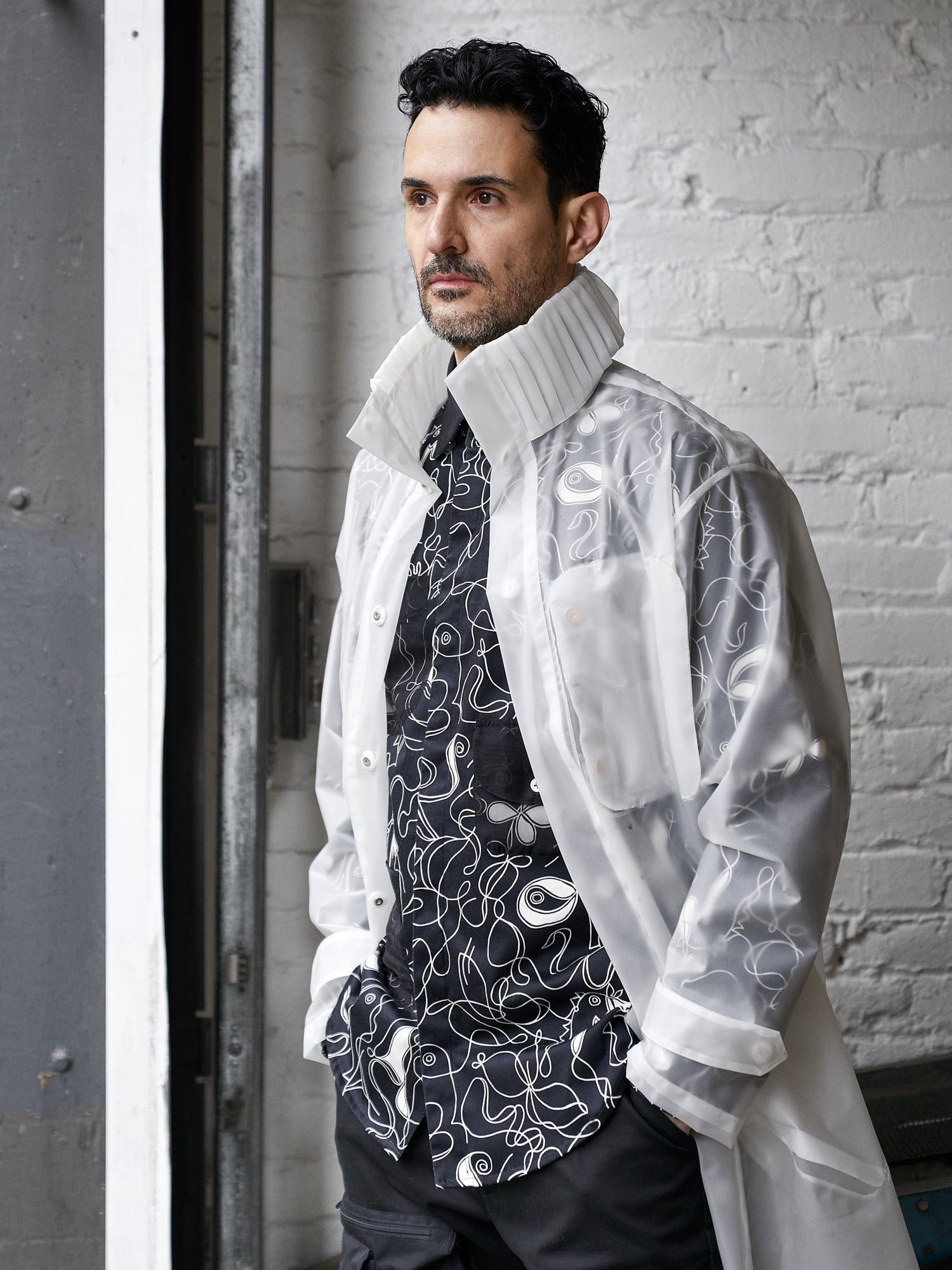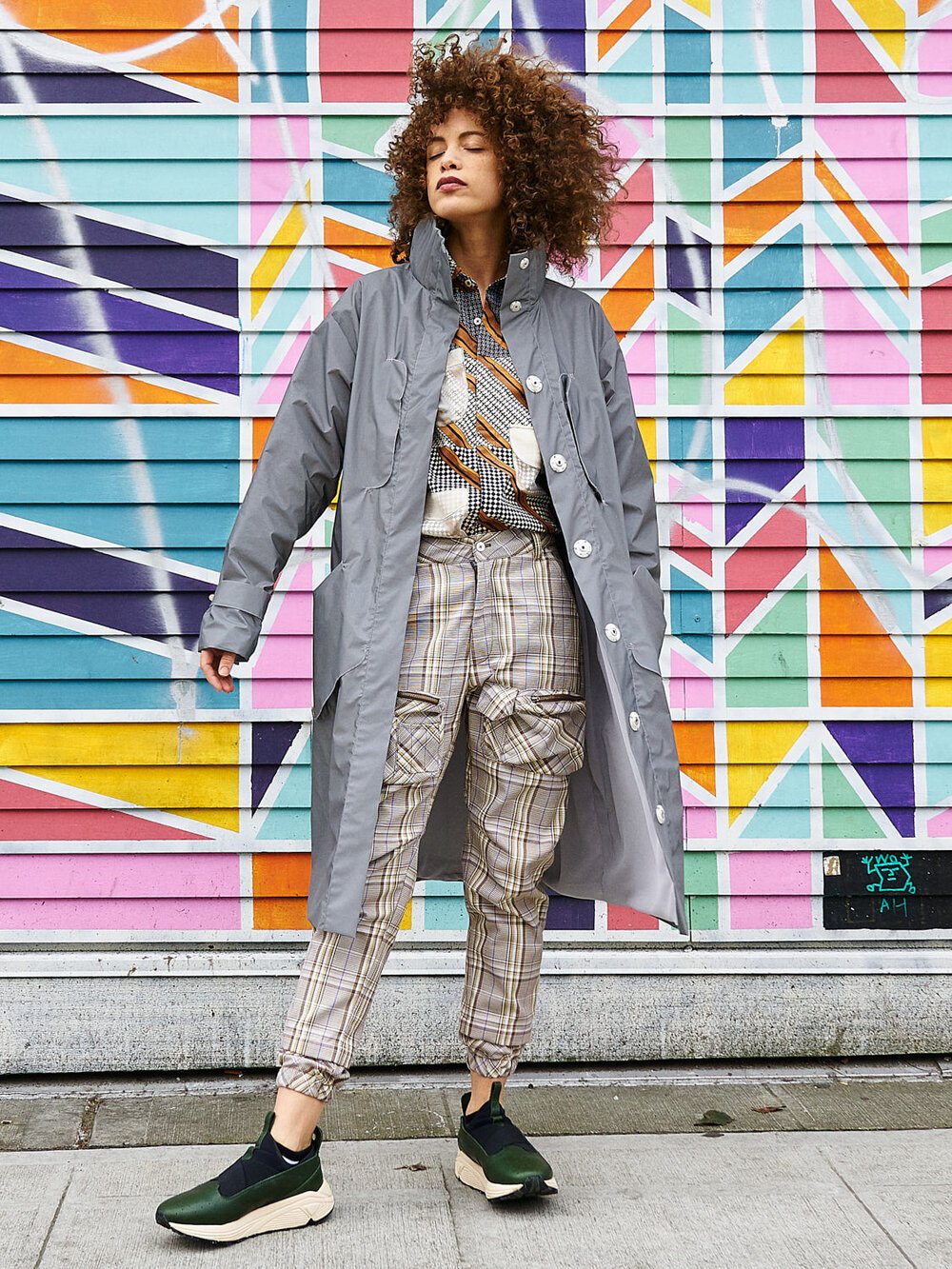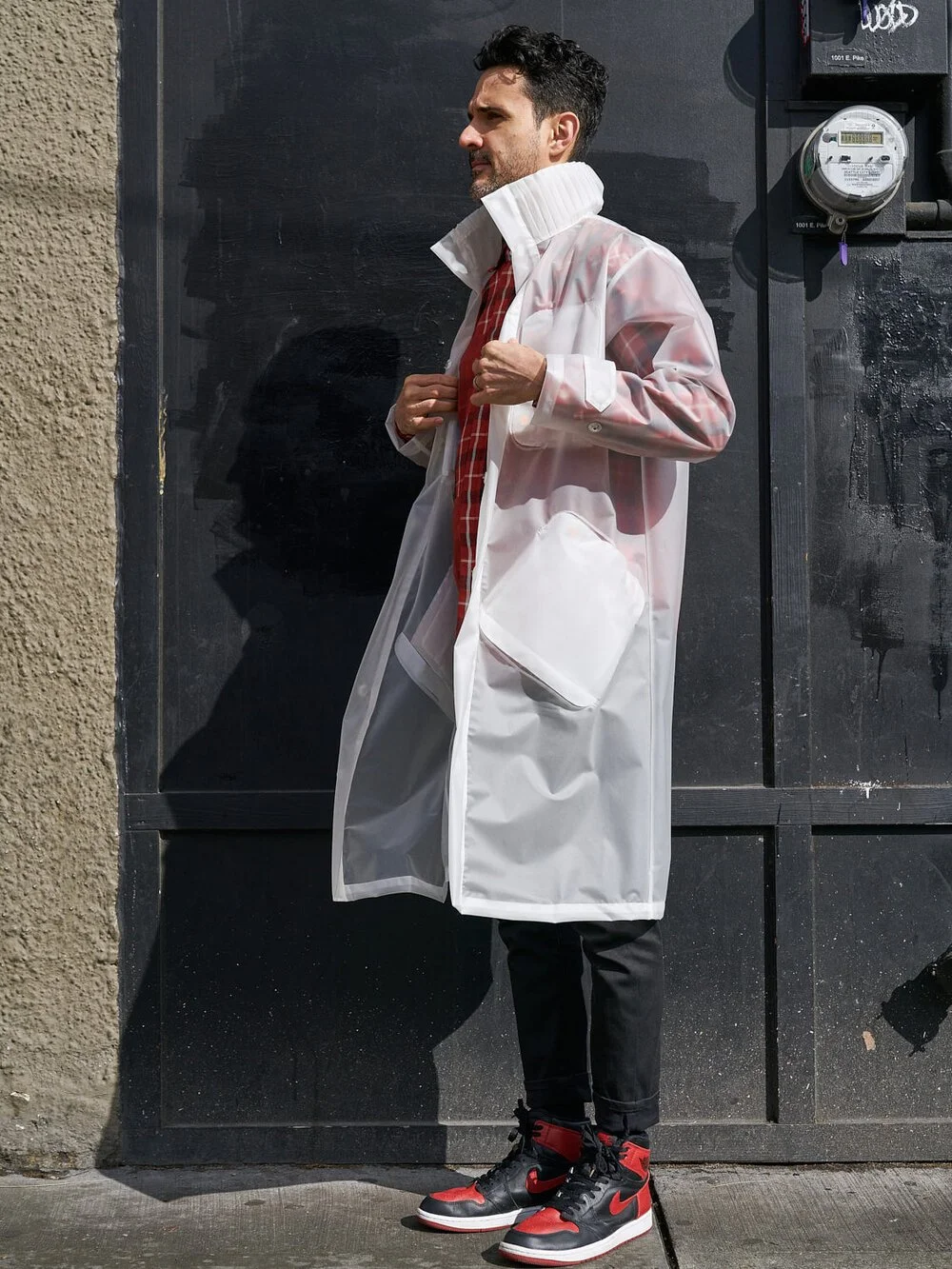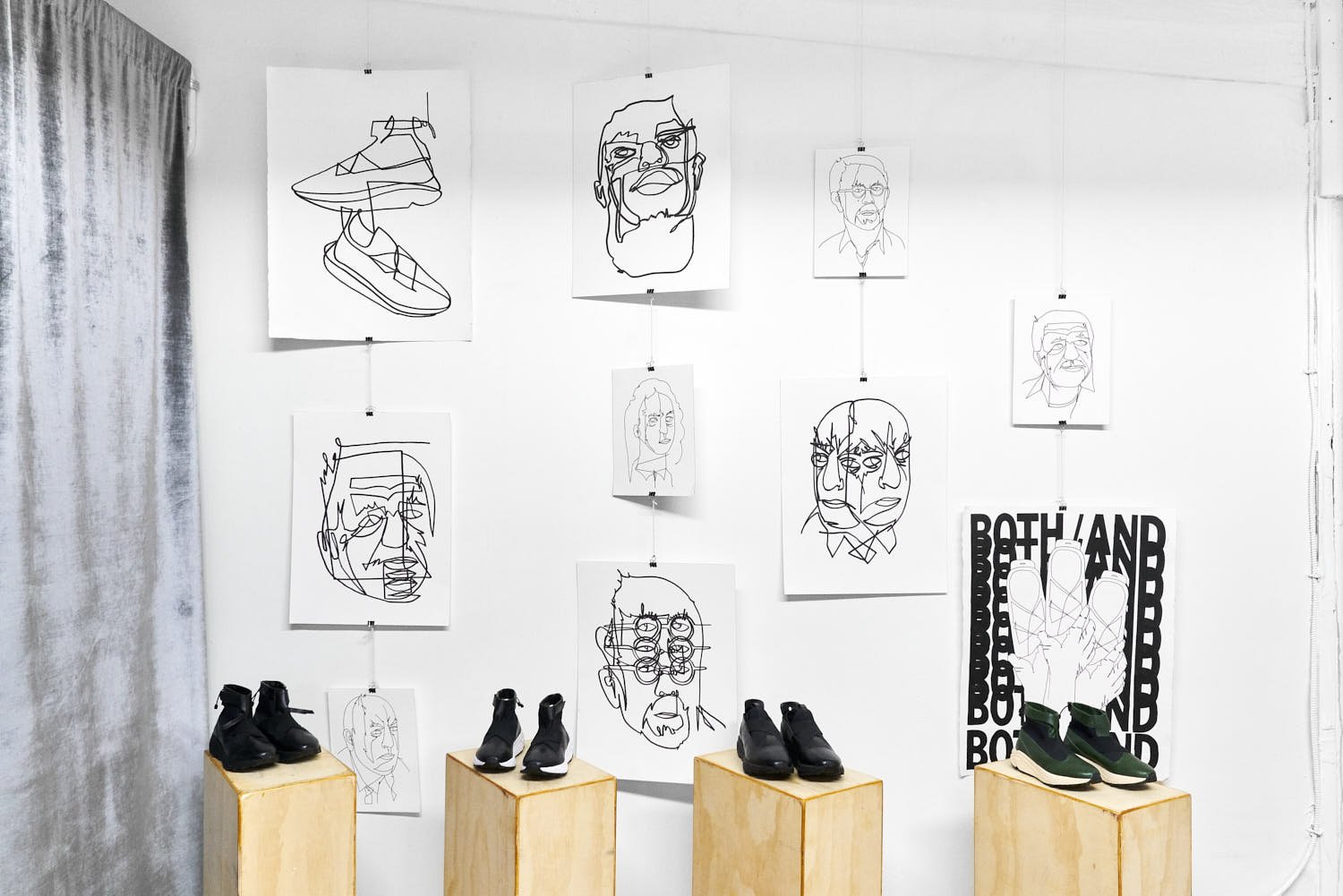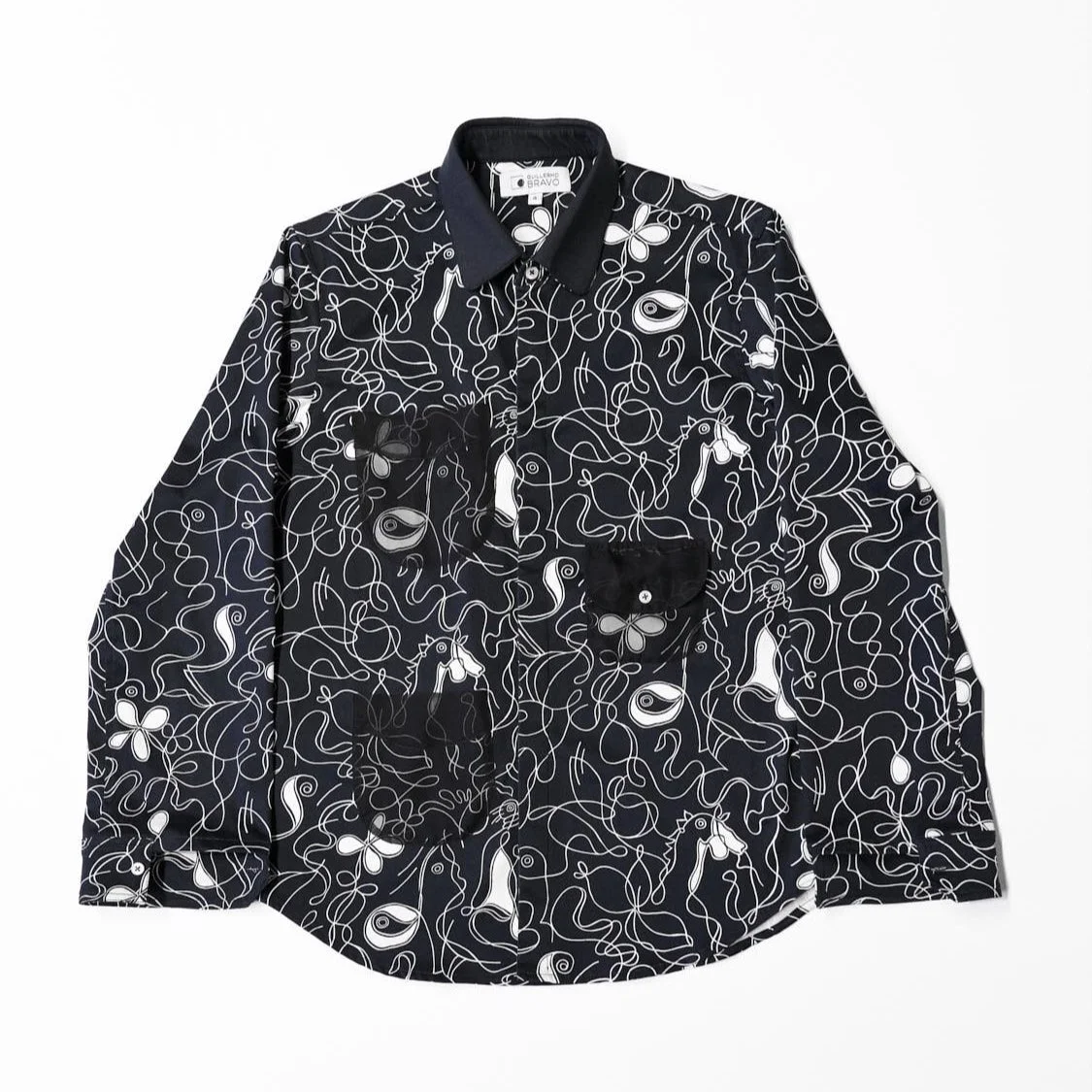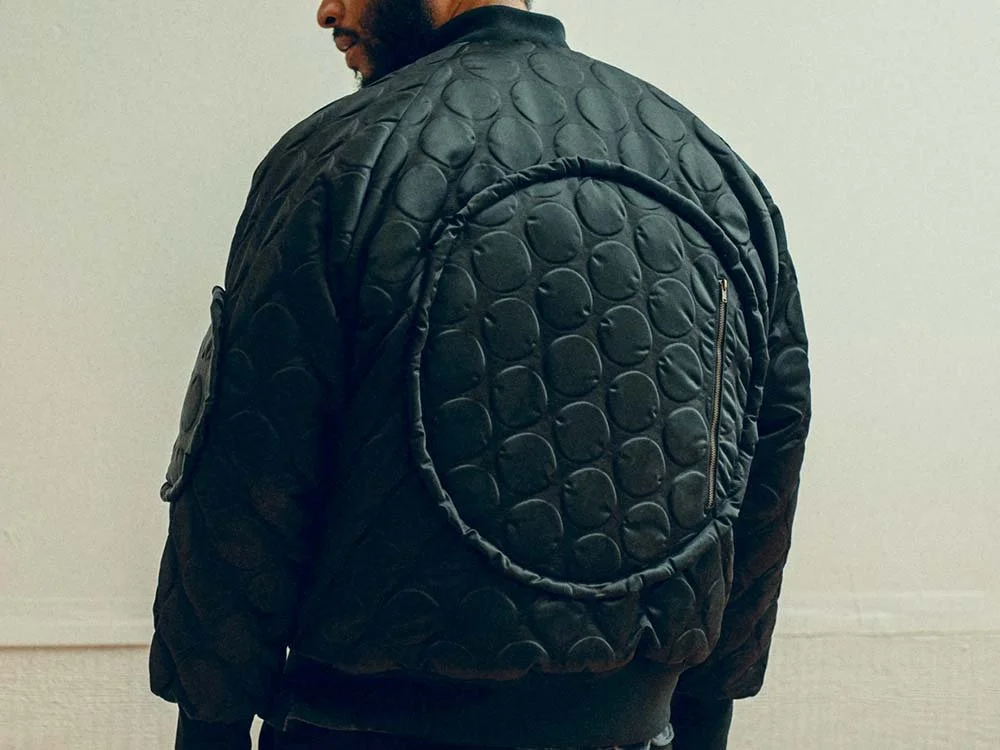
Luis Velez is the founder and creative director of streetwear label Guillermo Bravo based in Seattle. The brand began with footwear and quickly evolved into apparel that explores a genderless reimagining of contemporary daywear. Much of the creative approach could be summarized as applying intentional design to utilitarian needs with an artisan’s eye and a craftsperson’s touch. That this can be accomplished at scale is all the more impressive.
Guillermo Bravo's approach to footwear is sleek and modern, eschewing laces and embracing slip-on convenience, influenced by luminary contemporaries such as Matthew Williams and Pyer Moss. Guillermo Bravo's apparel is as utilitarian as it is inspired by the Pacific Northwest, with architectural patterns, organic textures, and innovative technologies that create an aesthetic fit for daily Northwest activities. Shirts are given exterior pockets not unlike a fisherman's vest. Raincoats are constructed with reflective materials that illuminate pedestrians on dark Northwest evenings.
But this functional foundation is appointed with upscaled flourishes including translucent organza pockets on dress shirts, wide-gusseted trousers for ease of movement, and configurable clips and pockets for individual convenience. All of this comes together to form what Luis refers to as a DIY approach to genderless style.
Note: Our interview with Luis took place April 4th, 2020 and reflects much of the uncertainty surrounding the complete shutdown of the international fashion supply chain at the time.
Luis Velez
BORN : Columbia
RAISED : Florida
EDUCATION : Creative Writing | Music composition & Performance
EXPERIENCE : Designer, Guillermo Bravo
LABELS : 1
COMPANIES : 2
FOCUS : PRÊT-À-PORTER | Footwear
STUDIO : YES
LOCATION : Seattle, WASHINGTON
“Just navigating these wild changes. Still waiting for factories to open up in LA so we can get some dates lined up to visit and then produce the upcoming apparel collection. As for the footwear, it’s going to take a little bit longer. What Italy has had to deal with is so much different than most of the world, and the [coronavirus] curve isn’t going away anytime soon. So for that, we’ll just kind of be on pause until we can develop the latest sneaker that we have on deck. The developers have had it for a while, but they acquired it just when the coronavirus hit, so we just have to wait and hopefully get back to it as soon as possible.”
“And outside of that, we’re just rerouting the plan for all things apparel and footwear, as much of the industry is doing right now. I mean, it’s a very, very different world now. But I feel like our spirits and health are definitely right where they should be. And I think it’s something I’ve always been able to have throughout my life, really. I’m definitely very motivated and always positive in that sense. I would say entrepreneurship is not for the faint of heart. You really have to be able to navigate and pivot, then rethink and pivot again.”
Once upon a time in Columbia
Luis’ family immigrated to the United States when he was a child. The path to citizenship was long and difficult, as his family had yet to communicate in English when they arrived in Florida. While his older sister quickly mastered the language, it would take Luis time to come into his own and develop his sense of self and purpose. But through it all, fashion was a universal language that Luis immediately understood and began put into practice.
“I think fashion, for me, started when I lived in Miami, being an immigrant and traversing the realms of not feeling very comfortable or confident in my own skin. I started to see and feel—though I didn’t conceptualize it at the time—that fashion allowed me to feel a lot more comfortable. And I quickly became obsessed with going to thrift stores trying to find really interesting pieces that further gave me that level of expression. And I think what started to shape me more as an individual was playing basketball in eighth grade, and being obsessed with that gave me a huge interest in sneakers. So I was always like the best-dressed kid in high school. But part of my upbringing, being an immigrant and having parents that didn’t really dominate the language, was that their efforts were more focused on finding us a good home and keeping us fed. And so I didn’t really explore much scholastically. I wasn’t the best student, but I was always artistic and athletic. I never really thought of fashion as a job. I never knew anybody that was a fashion designer or someone I could be mentored by in that sense.”
IMAGES FROM THE APRIL 2020 ISSUE FEATURING GUILLERMO BRAVO AW20 Selections.
Court side Fashion
Luis went on from fashion and athletics to pursue higher education. His focus was English and Spanish, achieving his Bachelor’s degree in creative writing. From there, he enrolled in music classes studying guitar, piano, and voice, then pursuing a career in music. But Luis never abandoned his love for fashion which began in thrift stores and evolved on the basketball courts of his youth.
“There’s a ton of nostalgia there for sure. That’s where my heroes—or my first idea of a hero—really was for me. Basketball players like Michael Jordan, David Robinson, Scottie Pippen, Karl Malone. They were all icons for me. As a kid who spent ten hours a day playing basketball, that was a very powerful connection. And the only way I could even get close to them was through sneakers. And it was those sneakers that took athletic footwear from a performance aspect to a lifestyle aspect. The Air Jordan 1 is the holy grail; it’s what really brought sneakers to a realm that’s now seen in America’s offices. And there’s also the comfort in sneakers. The design is really powerful because you’re in an industrial design realm, and it’s such a tremendous effort for so many people. You have to work with multiple factories. You have to meet your minimums, unlike some apparel. And that challenge is also really exciting. And there’s also that connection to people I really admire in the music community with Hip-Hop, R&B, Soul, and all the athletes as well that come with that. It’s super powerful to me. I think it’s at the core of who I am as a person.”
“I think fashion, for me, started when I lived in Miami, being an immigrant and traversing the realms of not feeling very comfortable or confident in my own skin.”

Designer Ambitions
“About five years ago, I was at a friend’s dinner party and was just chatting about sneakers. And he responded by saying, ‘Hey, you should do this!’ And I was like, ‘Do what?’ He said, ‘Have a sneaker brand.’ And I thought, ‘No, I’m a musician, I play music, and that’s what makes me happy.’ I didn’t go to design school. I didn’t know where to begin. He said, ‘How about this. You go to lunch with me and some of my friends who are serial entrepreneurs and we can kind of mentor you, show you the ropes, and maybe even help a little.’ So I did and got to hear from some great minds. And little by little, this kind of volume was awakening deep inside me and I just became obsessed. I put aside music and writing and got to work on this.”
“I decided to go back to school to learn how to make an Oxford and did studies in how to construct sneakers. I started taking industrial sewing classes to make sure that I can put together anything from a t-shirt to a pair of pants so that I can really get a sense of what construction was like. I also learned how to talk to a factory after I designed something. And I just took my time with it. I didn’t want to rush it.”
“My idea was that if I had something that touched the market, that could be really felt—something that was original and unique—that we would have a chance to play. And I knew what I wanted. I couldn’t really sketch it out, but I knew that if I could find the right partnership, that it could go really well. So I sought out design teams for creating footwear, which was very difficult, because you generally have to be in the country of production that you want to create in as well as connecting with the right factory that can create the footwear that you want create. And so having connections in those countries is super important. Also having connections with people who will be making your sole units, which come from a different place than where the uppers are made."
Guillermo Bravo’s initial footwear line photographed in their Capitol Hill studio, January 2020.
"I connected with ConceptKicks whose Founder and Creative Director is Daniel Bailey. The tech pack I sent him piqued his interest. He’s like, ‘Yeah, I really love the vibe and the feel of what you’re wanting to construct.’ He wanted to lead the design aspect as far as the initial sketches and renders. So we got the concept in mind and went through many iterations. So my first idea was to be a sneaker brand. That’s how it started.”
“As we were developing the sneaker, and I was thinking more about what this all was, I thought about my friends who probably don’t want to spend three hundred dollars on pair of sneakers. What do I do for them? How could they support me if they wanted to help a homie? So with that, I was like, why don’t I make t-shirts? How do I get the know-how? So I just decided to construct a t-shirt. My thought was to do crop-tops for women and a loose-fitting shirt for men. And then some socks. And as we were getting closer [with our sneakers] I thought, what about a pair of trousers? If I had trousers, I don’t have to pull from other brands for a lookbook. It could be just us. I was so excited I had a lot more control with exactly what I can do with all the apparel because I was gathering all the materials myself. And I didn’t have to work with two different factories to make stuff. And little-by-little, that evolved into non-gender-binary apparel and sneaker line. And that’s kind of where we’ve come to be.”
Guillermo Bravo AW20 Selections
“ I really learned to value my sense of self and that you’re only as good as your work and what you’re willing to put into it.”
Vintage Appeal
“I think there’s a lot of great brands at the moment that capture that vintage spirit and are also pushing the envelope in regards to what they’re doing with footwear. I think what started with the Air Jordan became a platform to move apparel into that space. For me, I’m very much about people who are doing things that play with luxury and the idea of avant-garde. The first person that comes to mind is definitely Matthew Williams and his brand Alyx. I think the type of innovation he’s showing is something that’s so fun and has this very luxurious sensibility. He has these swappable sole units that he did with Nike and Vibram to do this incredible collaboration. He also has this dress shoe that has almost a wedge sole unit that you can take off and transform into something more traditional. So I think he’s just somebody who’s doing things that are really, really neat.”
“I also like No.One out of LA that’s doing small handmade batches. They’re touching on stuff that I think is really pretty. Peterson Stoop out of the Netherlands is doing this really cool thing where you send them an Air Force 1 and they replace the sole unit with theirs which is cork based, and I think they’re doing really powerful stuff and engaging in a realm where it’s both up-cycling and making something super magical and beautiful.”
Luis had a plan, a style, a voice, a clear understanding of his market and the key figures within it. He had a brand identity. He had a support system and a network that encouraged him to move forward. But it was the resilience he developed throughout his upbringing that would prove to be his most valuable asset.
“Never becoming a good student until I got to college was really worrisome for my parents, obviously. And I guess in the back of my mind, it was worrisome for me. And it took being terrible at basketball for a while to know that you really had to earn everything in life. It showed me a sense of discipline. I still remember my first coach trying to show me how to shoot foul shots and just being so frustrated with what I was doing, like, ‘Oh my god, stop—I need you to get off the court.’ I remember just feeling like I’m going to be terrible forever. I had to learn that only through hours of dedication and very, very serious discipline would I get even a little bit better. And then I was able to transfer that to a scholastic setting, because in college I had a lot of catching up to do. But I really learned to value my sense of self and that you’re only as good as your work and what you’re willing to put into it.”
Contemporary Influences
“Streetwear itself has evolved into what we’re seeing now from Virgil Abloh, Samuel Ross, Matthew Williams, and many others. It started when people were taking luxury items and reimagining them with more urban style and looks. And now streetwear has touched an even larger part of the population, beginning with menswear. But what’s really exciting for me is to see it become even more androgynous. And it still has this sense of utility, so the ethos that designers are using is still very utilitarian. But it’s still very much touching on luxury. And I think how that’s coming into Seattle is that our demographic of people moving here is very different, and growing, and evolving.”
Luis Velez pictured in his Capitol Hill studio, January 2020.
“Eleven years ago when I moved here, the streets were ruled by Patagonia and The North Face. But for about the past five years, there’s been an influx of people that have a different concept of what fashion is, and it’s really filtering into those who’ve been here, so we’re seeing this new blend of what Seattle style really is. And I think Seattle is ready for it. People are really willing to step outside the box of the whole plaid and Patagonia, which are now no longer ruling the streets. You might see someone wearing a leather jacket, skirt, and some Vans, which is a lot more refreshing, just from my sense of personal taste. We’re even seeing really cool influences from Tacoma’s vintage markets, which are huge and actually carry a lot of really cool stuff.”
Although plans for Guillermo Bravo’s AW21 collection were placed on hold at the time of this interview, Luis was still producing limited batches in curated capsules. But for Luis, the future always looks bright.
“The idea with the new collection in regards to the multiple capsules we’ve created is this idea of mixed-metals that harken back to science class and creating alloys and stronger bonds through mixing different materials. So I wanted to take the idea of what we’re wearing and the utility of it, and mix luxury vibes into that. So we’re taking a red plaid that looks very work-wear and turning it into a multi-pocket shirt with organza touches. And we’re taking a Japanese cotton plaid and doing a modern take on the cargo pant. And we’re also looking at the idea of technology and pushing boundaries, making things smarter, more approachable. So I would say we’re exploring design intelligence. And that’s what we did with the trench coat. We made these inside pockets that are magnetized and using magnets designed for accessibility to replace the zipper. And we wanted to be able to slide a phone in without bouncing around, keeping it classy, but explore something avant-garde and more aligned with our definition of luxury. It’s this idea of allowing people to become part of the design and ultimately giving them more options. Owning less, but creating more with it.”
Guillermo Bravo AW21 Selections
“It’s this idea of allowing people to become part of the design. . .Owning less, but creating more with it.”



